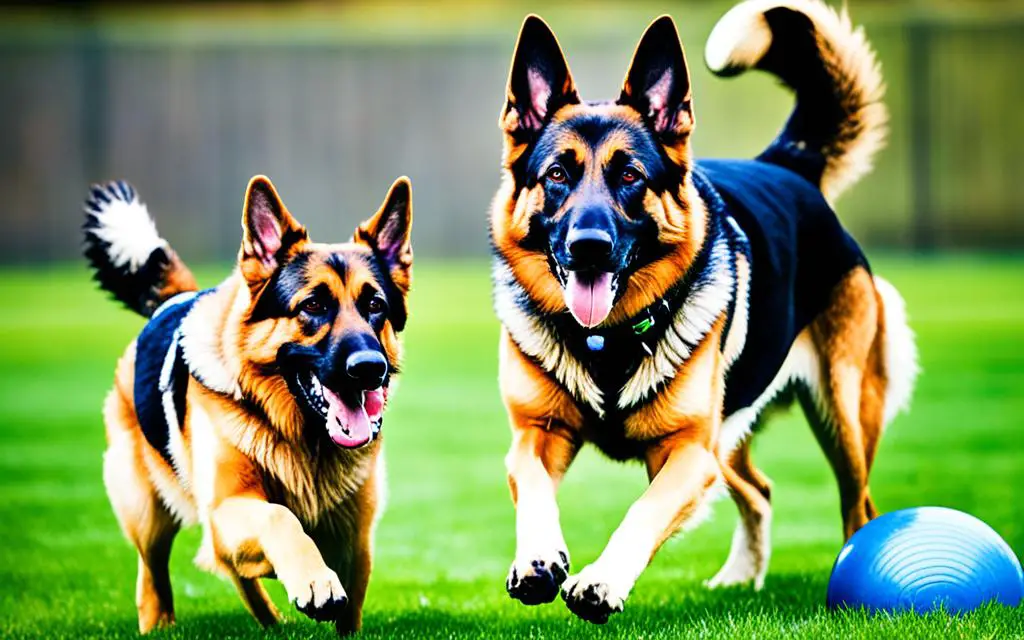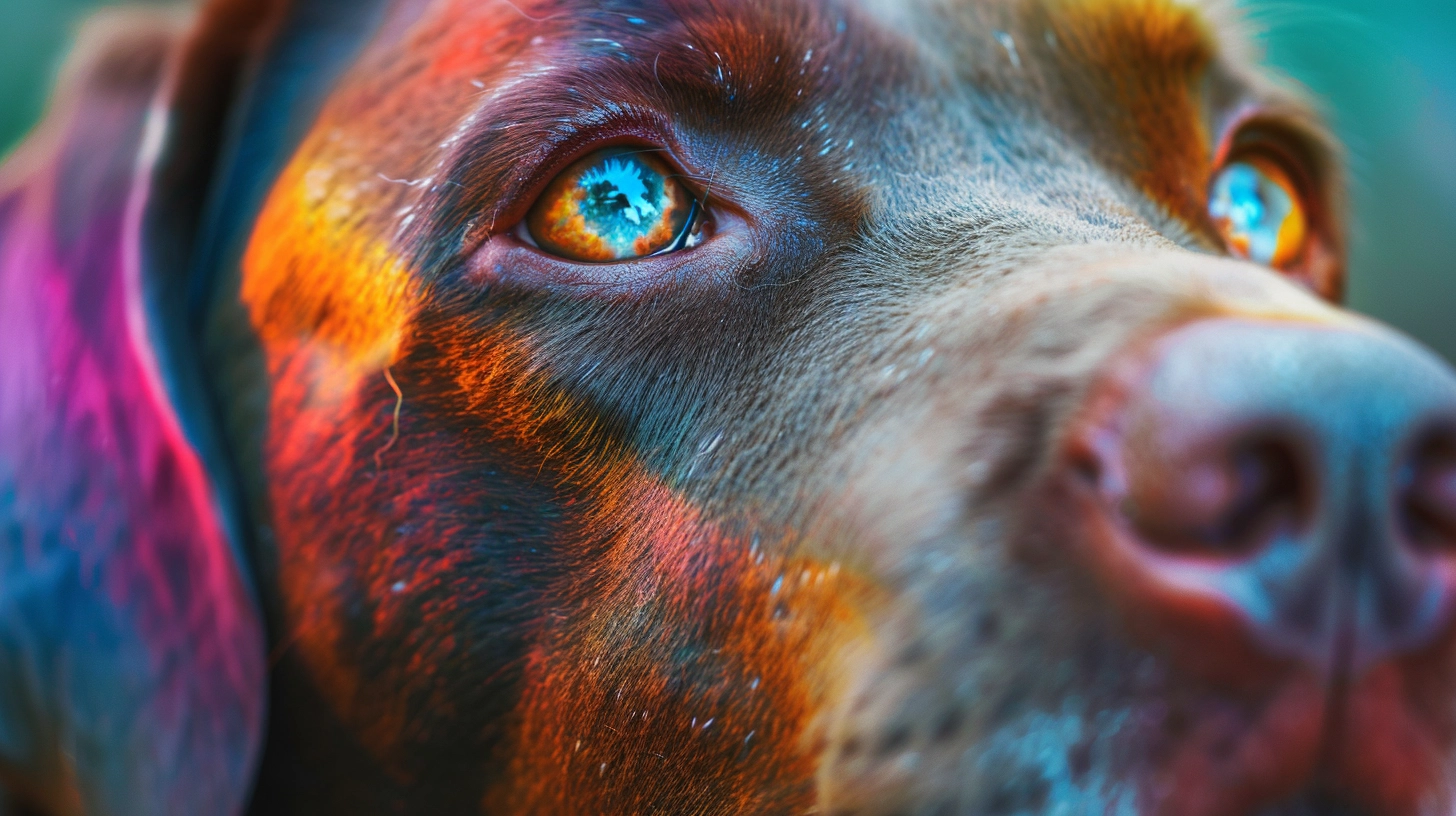As a proud German Shepherd owner, you know they’re more than pets. They’re part of the family. Their loyalty, intelligence, and love have won your heart. But what if they start to struggle with moving around?
Hip dysplasia is a common issue in German Shepherds. It’s often due to genetics, making some dogs more likely to get it. It’s tough to see them in pain, but luckily, there are actions you can take to help.
By taking steps to prevent hip dysplasia, you can keep your dog’s joints healthy. This includes picking a good breeder and making sure they get proper exercise. You have the power to positively affect their health.
We’ll cover what causes hip dysplasia, how to spot it, and ways to treat it. Plus, we’ll give you tips to prevent it. This way, your furry friend can stay happy, mobile, and healthy.
Key Takeaways:
- Hip dysplasia is a common condition that affects German Shepherds due to genetic factors.
- Choosing a certified breeder and controlling their diet and exercise can help minimize the risk of hip dysplasia.
- Early detection and proper treatment can improve the quality of life for German Shepherds with hip dysplasia.
- Lifestyle modifications, including weight control and pain management, can provide support for dogs with hip dysplasia.
- Your furry friend deserves a life free from pain and limitations, so let’s dive into these prevention tips!
What Causes Hip Dysplasia in German Shepherds?
Hip dysplasia in German Shepherds mainly comes from their genes. It’s essential to know how genes affect this health issue. German Shepherds are more likely to get hip dysplasia because of their genetics. Size and exercise also play a part in this risk.
The size of a German Shepherd can raise the risk of hip dysplasia. Bigger dogs often face this problem due to more pressure on their hips. The large size and weight of a German Shepherd can make genetic issues worse. This increases their chances of getting hip dysplasia.
Exercise is key in preventing hip dysplasia, especially hard exercise when young. Puppies doing too much or very tough activities can stress their hips. This stress might lead to hip dysplasia as they grow. So, it’s important to find a good mix of exercise and rest. This helps their hips develop right.
Knowing these causes helps owners prevent hip dysplasia in their German Shepherds. By watching out for genetics, not overdoing exercise, and creating a good living space, owners can lower the risk. This helps keep their dogs healthier.
Popular German Shepherd Products
- Perfect tasty blend of Glucosamine, Chondroitin, Perna Canaliculus, and Omega-3 Fatty Acids. Dogs love the taste. They think it is treat time!
- Z Flex Minis is our small dog formula and Z Flex Max is our medum & large dog formula
- Supports the joints of working, older and active dogs. Helps to upkeep joint mobility, flexibility and healthy bone structure. Relieve pain from inflammation, arthritis, hip dysplasia, aging, stiffness, and sore joints
- Made in FDA, USDA and FSIS Regulated Manufacturing Facilities. Buy with confidence! Excellent customer service and return policy. 100% satisfaction guaranteed!
- Healthy Breeds offers an assortment of dog healthcare products, grooming products and treats for over 200 breeds! Make sure to search for your breed! Click the Healthy Breeds hyperlink above the title to see our amazon storefront!
- VET RECOMMENDED FORMULA- A daily nutritional supplement with a synergistic blend of essential vitamins, minerals, and antioxidants!
- TASTY SOFT CHEWS- Our delicious heart shaped soft chews help maintain optimal health in dogs no matter the breed, age or activity level! Easy to administer!
- DIETARY SUPPLEMENT- Perfect to supplement your dog’s diet. Helps with skin & coat, digestion, bladder support, and overall health!
- MADE IN USA- Made in FDA, USDA and FSIS Regulated Manufacturing Facilities. All raw materials utilized are of the highest quality and are evaluated for purity and potency prior to use.
- Healthy Breeds offers an assortment of dog healthcare products, grooming products and treats for over 200 breeds! Make sure to search for your breed! Click the Healthy Breeds hyperlink above the title to see our amazon storefront!
- THE GERMAN SHEPHERD PUPPY: Take home your very own German Shepherd Puppy from Living Nature! This plush pet is the perfect addition to your soft toy collection. Cuddly by nature and accurate by design, collect all your favourite dogs in premium cuddly toy versions for hours of fun with your new furry friends. Our Shepherd stands 16cm tall.
- HIGHLY ACCURATE DETAILING: Our soft toy dogs are beautifully crafted with accurate detailing from the fur, eyes, and features. Trimmed to perfection, your German Shepherd Puppy sports long, soft brown and black fur, big dark eyes and classic pointy ears. Our artists add shading and texture by hand for a realistic finish down to the very last detail.
- YOUR CUDDLY CANINE COMPANION: Protective and obedient companions, German Shepherds are a popular breed due to their high intelligence and striking appearance. Your Shepherd is a fiercely loyal friend who will provide the best hugs at bedtime!
- EDUCATIONAL FACT TAGS: Our German Shepherd Puppy cuddly toy comes with an educational tag so you can learn all about your favourite pup – from their behaviour, diet and even how to take care of them! Did you know? The first dog to be used to aid the blind was a German Shepherd.
- NATURLI ECO-FRIENDLY TOYS: Finding eco-friendly toys for kids can be tough, but we’re committed to doing things sustainably here at Living Nature. Our German Shepherd Puppy is made using Naturli recycled post-consumer PET plastic from bottles and containers that would otherwise end up in landfill.
- A COMPLETE CANINE SUPPLEMENT – A multivitamin (Vitamins A, B, C, D, E, K & other minerals) PLUS Essential Fatty-Acids for Skin & Coat Support, Glucosamine for Hip & Joint Support AND Probiotics to promote the absorbtion of nutrients for Digestion and Gut Health.
- SCIENTIFICALLY FORMULATED 4-IN-1 FORMULA – Contains Glucosamine+Chondroitin & Calcium for joints, Omegas 3, 6 & 9 for healthy skin & fur, and Probiotic microorganisms to help maintain appetite and support the overall health of their digestive system.
- DELICIOUS TASTE THAT DOGS LOVE – The yummy chicken flavor makes giving your dog their vitamins an easy & fun process. Even the pickiest pup will love these treat-style supplements!
- MADE IN USA – Made in FDA, USDA and FSIS Regulated Manufacturing Facilities. All raw materials utilized are of the highest quality and are evaluated for purity and potency prior to use.
- Healthy Breeds offers an assortment of dog products including health care, grooming, dental care and treats for over 200 breeds! Make sure to search for your breed! Click the Healthy Breeds hyperlink above to see our Amazon storefront
- A COMPLETE CANINE SUPPLEMENT – A multivitamin (Vitamins A, B, C, D, E, K & other minerals) PLUS Essential Fatty-Acids for Skin & Coat Support, Glucosamine for Hip & Joint Support AND Probiotics to promote the absorbtion of nutrients for Digestion and Gut Health.
- SCIENTIFICALLY FORMULATED 4-IN-1 FORMULA – Contains Glucosamine+Chondroitin & Calcium for joints, Omegas 3, 6 & 9 for healthy skin & fur, and Probiotic microorganisms to help maintain appetite and support the overall health of their digestive system.
- DELICIOUS TASTE THAT DOGS LOVE – The yummy chicken flavor makes giving your dog their vitamins an easy & fun process. Even the pickiest pup will love these treat-style supplements!
- MADE IN USA – Made in FDA, USDA and FSIS Regulated Manufacturing Facilities. All raw materials utilized are of the highest quality and are evaluated for purity and potency prior to use.
- Healthy Breeds offers an assortment of dog products including health care, grooming, dental care and treats for over 200 breeds! Make sure to search for your breed! Click the Healthy Breeds hyperlink above to see our Amazon storefront
Signs and Symptoms of Hip Dysplasia in German Shepherds
Spotting the signs of hip dysplasia early in German Shepherds is vital. Knowing these signs helps you care for your dog quickly. This can make a big difference for your furry friend.
Common Symptoms
- Limping or lameness: If your German Shepherd limps or has trouble with their hind leg, it’s a sign. They may not put weight on the leg, or they might drag it.
- Decreased activity: A dog with hip dysplasia may play less. They might not want to run, jump, or play like before.
- Stiffness: This condition makes your dog’s hind legs stiff. Your German Shepherd might find it hard to move, especially getting up.
- Difficulty rising from a sitting position: Trouble standing up could mean hip dysplasia. You might see your dog struggle to get up.
- Signs of pain: Watch for signs your dog is in pain. They might whine or not want you to touch their hip area.
If your German Shepherd shows any signs or you’re worried, see a vet. The vet will check your dog and might suggest an X-ray. This helps confirm hip dysplasia and lets the vet create a treatment plan.
Expert Insight:
“Watching how your German Shepherd moves and plays is key to spotting hip dysplasia. Don’t overlook small changes. Acting early is important for your dog’s health and comfort.”
| Symptoms | Occurrences |
|---|---|
| Limping or lameness | 80% |
| Decreased activity | 65% |
| Stiffness | 70% |
| Difficulty rising from sitting position | 75% |
| Signs of pain | 90% |
Diagnosing Hip Dysplasia in German Shepherds
To find out if a German Shepherd has hip dysplasia, a vet does a full check-up and uses x-rays to see the hip’s condition. The vet will move the dog’s back legs to check for looseness and look for pain or less movement. They will also ask about the dog’s health history and any symptoms.
The vet feels the dog’s hip joints for any odd feel or pain during the check-up. They watch how the dog walks to spot any limping or stiffness. If hip dysplasia seems likely, more tests like x-rays are needed to be sure.
X-rays are key for spotting hip dysplasia. They show clear pictures of the hip joints. This lets the vet see how loose the joints are and if the bone has grown oddly. These images help figure out how bad the condition is and what treatment is best.
It’s crucial to spot hip dysplasia early to manage and treat it right. If you see any signs of hip dysplasia in your German Shepherd, see a vet quickly for a full check-up and the right tests.
After finding hip dysplasia in your German Shepherd, the vet will help make a treatment plan just for your dog. This might include medicine for pain, physical therapy, keeping the dog’s weight in check, and sometimes surgery.
Getting an early diagnosis with a full vet check-up and x-ray is vital. It’s the best way to handle hip dysplasia in German Shepherds and help them have a better life.
Preventative Measures for Hip Dysplasia in German Shepherds
Hip dysplasia in German Shepherds can’t always be stopped. But, certain steps can help lower the risks. By doing these things, owners can keep their dogs’ joints healthy. This can lower the chances of hip dysplasia.
Choosing a Certified Breeder
Picking the right breeder is key when getting a German Shepherd. A good breeder checks the parents for hip issues before breeding. This choice helps avoid bringing a dog with hip problems into your home.
Food Portion Control
It’s important to watch how much your dog eats. Too much food can make your dog heavy. This extra weight can hurt their hip joints. Feed your German Shepherd the right amount for its size and activity. This keeps them at a healthy weight.
Regular Exercise
Exercise keeps your German Shepherd healthy. Find the right balance to avoid hurting their hips. Swimming and walking gently are great. They keep the joints healthy without too much stress.
Too much exercise is not good. Avoid hard activities like jumping a lot, especially when they’re young. A good exercise plan builds muscles around the hips. This can help avoid hip problems.

To lower the risk of hip dysplasia, follow these steps. Choose a breeder carefully, control how much your dog eats, and exercise them right. These actions can make a big difference for your dog.
| Preventative Measures | Benefits |
|---|---|
| Choosing a Certified Breeder | Ensures parent dogs are free from hip dysplasia |
| Food Portion Control | Maintains a healthy weight and reduces strain on the hip joints |
| Regular Exercise | Promotes muscle strength, joint stability, and overall well-being |
Treatment Options for German Shepherd Hip Dysplasia
When it comes to treating German Shepherd hip dysplasia, the options available depend on the severity of the condition. Veterinarians may recommend different approaches, including surgery, physical rehabilitation, and the use of joint supplements and pain management medications.
Surgical Intervention
In more severe cases of hip dysplasia, surgery may be necessary to improve the dog’s quality of life. One common surgical procedure is total hip replacement, where the damaged hip joint is replaced with an artificial joint. This surgery can provide significant pain relief and restore mobility in German Shepherds with advanced hip dysplasia.
Physical Rehabilitation
Physical rehabilitation plays a crucial role in managing hip dysplasia and promoting joint health. With the guidance of a professional canine physical therapist or veterinarian, specific exercises and therapies can be tailored to strengthen the muscles surrounding the hips and improve joint stability. This can help manage pain, increase mobility, and enhance overall functionality.
Joint Supplements and Pain Management Medications
In addition to surgical intervention and physical rehabilitation, joint supplements and pain management medications may be recommended to alleviate discomfort and improve joint function in German Shepherds with hip dysplasia. Joint supplements containing ingredients like glucosamine and chondroitin sulfate can help support joint health and reduce inflammation. Pain management medications, such as non-steroidal anti-inflammatory drugs (NSAIDs), may be prescribed to provide relief from pain and stiffness.
“Treating hip dysplasia in German Shepherds requires a multifaceted approach that combines surgical intervention, physical rehabilitation, and the use of joint supplements and pain management medications. By combining these treatment options, veterinarians can help improve the quality of life for dogs with hip dysplasia and promote their long-term joint health.” – Dr. Emily Thompson, DVM
It’s important to consult with a veterinarian to determine the most appropriate treatment plan for your German Shepherd with hip dysplasia. They will consider the severity of the condition, the dog’s age, overall health, and lifestyle to develop a personalized approach that addresses the specific needs of your furry friend.
With the right combination of treatments and management strategies, German Shepherds with hip dysplasia can experience improved comfort, mobility, and overall well-being.
Prognosis and Management of Hip Dysplasia in German Shepherds
The outlook for German Shepherds with hip dysplasia varies. It depends on how serious the condition is and how it’s managed. If spotted early and treated right, these dogs can have long and happy lives.
Managing hip dysplasia in German Shepherds takes a well-rounded approach. This approach aims to keep joints healthy and improve the dog’s life. The key is to lessen pain, better mobility, and make life more enjoyable. Effective ways to manage this condition include:
- Weight control is key. Keeping your dog at a healthy weight reduces stress on their joints. Watching their diet and food amounts can help stop too much weight gain, easing hip pain.
- Changing how much and what type of exercise they get is essential. Low-stress activities, like swimming or short walks, are best. They keep pressure off the joints but keep your dog active.
- Joint supplements are beneficial. Supplements with glucosamine, chondroitin, and omega-3 fatty acids support joint health. They can also cut down on inflammation, helping your dog move better and feel less pain.
- Managing pain is sometimes necessary. For severe pain, vets may prescribe medications. These can include anti-inflammatory drugs, making your dog more comfortable.
Regular check-ups with the vet are crucial. They help keep track of the condition and make needed changes to the care plan. X-rays and other tests can show how the joints are doing and if treatments are working. By following a detailed care plan and working with a vet, owners can help their dogs lead full lives, even with hip dysplasia.
| Treatment Options | Pros | Cons |
|---|---|---|
| Surgery (Total hip replacement) | – Provides long-term pain relief | – Expensive\n- Requires an extended recovery period |
| Physical rehabilitation | – Improves strength and mobility | – Requires ongoing commitment\n- May not be suitable for all dogs |
| Joint supplements | – Supports joint health\n- Reduces inflammation | – Results may vary\n- Requires consistent administration |

Supporting Your German Shepherd with Hip Dysplasia
Helping a German Shepherd with hip dysplasia means changing their lifestyle for better joint health and pain control. By doing this, you help improve your furry friend’s life. Here are some key changes to make:
Maintain an Ideal Weight
It’s important to keep your German Shepherd at the right weight. Too much weight can put extra stress on their joints. Talk to your vet about the best weight for your dog and how to adjust their diet.
Create a Comfortable Environment
Make sure to provide a cozy and supportive bed for your dog. A bed made for orthopedic support can relieve joint pressure. It can really help your dog rest and sleep better.
Modify Exercise Activities
Avoid exercises that could hurt your German Shepherd’s hips. No jumping or rough play. Choose gentle activities like swimming or walking instead. Work with your vet to pick the best exercises.
Incorporate Joint Supplements
Adding joint supplements might help your dog. Ingredients like glucosamine and chondroitin support joint health. But, always check with your vet before starting any supplements.
Pain Management
Managing pain is key for dogs with hip dysplasia. Your vet might suggest medications to ease pain. Be sure to follow their advice closely and watch for any side effects.
Every dog with hip dysplasia has different needs. Regular vet visits and advice are essential for the best care. Supporting your German Shepherd with hip dysplasia needs dedication and a special plan.
Supporting your German Shepherd properly requires effort, patience, and customized care. Through lifestyle changes, pain management, and focusing on joint health, you can give your dog a happier, more comfortable life.
Conclusion
Hip dysplasia is common in German Shepherds and affects their joints and well-being. But, knowing the causes and signs helps. There are ways to prevent and treat it, so owners can help their pets stay healthy.
To keep German Shepherds’ joints healthy, prevention is crucial. It starts with choosing a breeder who checks the dogs’ hips. Also, feeding them the right amount of food helps. And, exercise that strengthens muscles without hurting the hips is important.
When hip dysplasia does happen, there are treatments like surgery and physical rehab. Joint supplements can also be helpful. A plan made with a vet and giving your dog care can make their life better.
It’s important to catch hip dysplasia early. Watch for signs and get your dog checked by a vet quickly. This way, German Shepherds with hip dysplasia can have a good life.




Leave a Reply